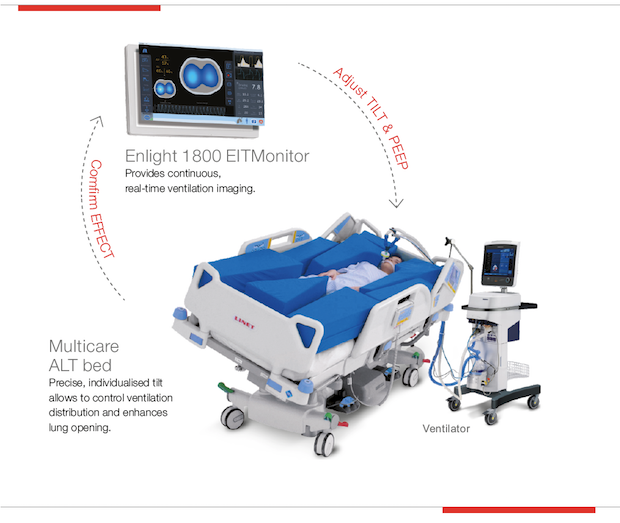![]()
WATCH THE RECORDED WEBINAR
Timely, Noninvasive and Bedside Individualization of Ventilation Care
|
The main speaker: |
Prof. Marcelo Amato, M.D., Ph.D. |
 |
Born on 25th June, 1962, initiated his medical studies in 1980 at the Faculdade de Medicina da Universidade de São Paulo, with specialization in Pneumology and Intensive Care Medicine at the Pulmonary Division of the Hospital das Clínicas. In 1996 he finished with success his doctoral post-graduation. In 1996 and 1997 he finished Post doctoral training in Minneapolis, working at the Lab. of Prof. John Marini and in Rotterdam, with Prof. Lachmann. In 2008 he obtained his professorship at the University of São Paulo, Pulmonary Department. Main areas of research: Protective Mechanical Ventilation, Electrical Impedance Tomography, Technological Solutions for Mechanical Ventilation. |
The webinar brought you LINET Group in cooperation with TIMPEL Medical.
Just simply register and watch the full record of the webinar.
HOW IT WORKS?
EIT is a noninvasive, radiation-free clinical imaging tool to monitor, in real-time and at the bedside, the distribution of ventilation. Enlight 1800 EIT provides a method to estimate pulmonary collapse and overdistension using regional compliance information, which enables a proper PEEP titration. It provides also timely evaluation of the effects of changing the patients' positioning. Both play a significant role in ARDS management.

QUESTIONS & ANSWERS FROM THE LIVE WEBINAR
How would you estimate an ideal PEEP without EIT available? (Michal Skribuckij)
Other methods to be able of assisting in the choice of ideal PEEP are: CT can be performed at different levels of PEEP measuring the amount of collapse, but with difficult clinical application; Ultrasound Also this technique is available at the bedside it suffers, from several limitations, as the lack of spatial resolution and the limited penetration of ultrasound; Compliance of respiratory system can also be used in decreasing levels of PEEP, greater compliance can assist in the method of choosing best PEEP, however, this method has a limitation when is used to apply in patients with areas of regional collapse such as pneumonia.
What difference may we expect if we have only 15°? (Maurico Valero)
Tilting the patient at 15 ° is still expected to benefit from recruitment of the non-dependent lung, but the transpulmonary pressure is greater when we tilt at 30 °, because we have more tissue in the non-dependent position.
Especially for patients with COVID, is the best study to keep the patient as long as possible in intubated treatment? (Martin Wabscheg)
Patients monitored in Wuhan had an average of 4 days on non-invasive ventilation before being intubated, post-intubation compliance was low around 20 mL/cmH2O, patients in Italy are having an early intubation and compliance is around 40-50 . Therefore, we must follow the indication of invasive support and use strategies that can promote alveolar recruitment such as lateralization.
How ALT affect the gas exchange between the lungs, is it affected also by gravity? (Kamel Aouichi)
Using an appropriate PEEP level and avoiding collapse or dependent lung has higher perfusion rates and greater non-dependent lung compliance, Perfusion is also affected by gravity but PEEP level affected more than gravity.
You showed the behaviour of tilting in spontaneus breathing. What should we expect regarding ventilation and areation in patient under mechanical ventilation with higher PEEP values? (Camila Cestaro)
In spontaneous breathing the diaphragm acts by slightly shifting the ventilation to the dependent region, however during mechanical controlled ventilated is expected the same behavior, non-dependent areas are recruited under controlled breaths this behavior could be empowered without muscle effort.
May we state that lateral tilt is possible alternative to proning the patient without inherent risks for proning? (Maurico Valero)
Lateralization is a safe option with the potential for recruitment when compared to increased inspiratory pressures and/or risks inherent in the prone position.
Do I have to keep good lung down? (Fernando Jajqueira)
The dependent lung suffers the weight of the non-dependent lung and the mediastinum, if it is a healthy lung there will be no prejudice when returning to a supine position, but if it is a lung presenting some degree of injury an adequate PEEP level will maintain the open lung.
For how long we apply later position? Periodic or limited? (Tarek Eletr)
When we have only one sick lung, we can keep that lung up until we see a stable aeration through the EIT. In situations where the two lungs have areas of atelectasis the lateralization should be alternated, using levels of PEEP that can be maintained or lungs that were opened when placed down.
How frequent should we change position of the patient? (Jad Assi)
The time may vary between patients, but the results so far show that patients must remain at least 10 minutes in each position for bilateral diseases, in unilateral diseases the time can be longer as long as the dependent lung is ventilated with a level of Enough PEEP to not generate a large area of collapse. Ideally, EIT can help by showing the change in aeration over time. Without EIT 30-60 minutes each side is often used. Analysis of blood gases may advice you about effectivity of lateral tilt.
In your opinion, is there any condition , when lateral titl would be contraindicated? (Maurico Valero)
The rotation is performed with pillows that keep the patient stable and safe, the weight is distributed throughout the body in order not to overload some areas as with the lateral decubitus, in this way, even patients in postoperative thoracic surgery can benefit lateralization.
Should I switch always between L and R or can I keep one side down? (Jan Louis)
It will depend on the patient´s most compromised lung. If he has, for example, an injury in the left lung and the right one is healthy, you can alternate between right lateral tilting and supine position.
Do you have any data about reperfusion of lung during the tilt? How it will help to distribute the blood? (Alexandr Širin)
The perfusion will increase in the dependent lung due to gravity.
How we can get copy of the presentation as I would like to distribute to clinicians in my area? (Damien Mckeaveney)
The link to see webinar offline is available already on webinar registration page.
Is there any difference in the effect of ventilation and FRC if the patient beeing ventilated with high or low PEEP? (Camila Cestaro)
The FRC will increase in the non dependent lung. Regarding ventilation, usually with higher PEEP values, the bottom one ventilates more, and with lower PEEP, the non dependent one, depending where the alveoli are in the PxV curve.
How deep the sedation scale be for ALT? RASS or SAS (Martin Wabscheg)
There is no restriction regarding sedation related with tilt, since the bed has several ways to protect the patient from potential falls. If patients is not sedated than their compliance is necessary component.
Como correlacionar LA FRC noc los efectos de cambios de posición? (Como Estrada)
The FRC will be represented in the baseline on the plethysmogram showed by EIT. When you position the patient to the right side, for example, the left lung goes to the non dependent region, and increases FRC, gets more aerated
What is recommended tilt degree? (Vít Karvay)
The bed allows tilting starting at 1º, maximum 30º. We recommend 30º for better effect. Hemodynamics stability is necessary for maximum tilt. During blood pressure check always consider gravity effect.
How would this technic compare with prone position? (Tarek Tantawy)
Lateral tilting is more used for asymmetric pathologies between right and left lungs. Is the same principle as prone, when you consider positioning one side in the dependent region and the other in non dependent. Lateral tilt can be consider also as pre-proning strategy.